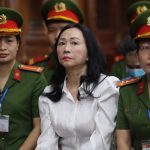President Joe Biden heads to India this week with a rare task for U.S. leaders — courting the developing world.
Biden’s trip to the G-20 meetings in New Delhi marks the most concerted effort by the United States in decades to win the favor of so-called developing nations — more than 70 countries, concentrated in the Southern Hemisphere, with high debt burdens and poverty levels.
Those nations, long neglected by Washington, are critical to Biden’s economic agenda. He’ll need to increase trade with many of them — from Bolivia to Indonesia and the Democratic Republic of the Congo — to secure the raw materials and components needed for his domestic manufacturing renaissance. And he will need their buy-in for his campaign to rewrite the rules of the global economy to encourage fair trade between democracies, and penalize China’s state-led industries.
Biden’s plan is to buy them off. The administration says the U.S. and other Western nations — not to mention their financial institutions — need to boost their financing of infrastructure projects in the developing world. That, they hope, will provide a down payment to keep those nations from floating further toward Beijing’s orbit, even in the absence of traditional trade negotiations that Biden has eschewed since taking office.
The administration “is seeking to enhance its value proposition” to developing nations, national security adviser Jake Sullivan told reporters during an August preview of the G-20 trip, “broadly through investments in the kinds of things that these countries are looking for,” like roads, ports and clean energy infrastructure.
That investment-first strategy marks a dramatic shift from decades of U.S. economic policy that largely focused on removing tariffs and other trade barriers in hopes that private U.S. companies would rush in and industrialize poorer nations. That was the broad thinking behind the establishment of the World Trade Organization at the turn of the century, but administration officials say that agenda has now run its course.
“We don’t see tariffs as being at the core of trade policy. We don’t see trade policy as being at the core of international economic policy,” deputy national security advisor for International Economic Affairs Mike Pyle said at a late June appearance at the Carnegie Endowment. “Just as the agenda with other industrial economies begins with investment, so too the agenda for the developing world begins with investment.”
It’s a playbook Beijing has already pursued for more than a decade. China has pumped a trillion dollars into infrastructure and development projects in over 130 nations around the world in its Belt and Road Initiative — building not just ports and bridges, but goodwill among many nations.
“We start at a significant deficit” compared to China, said former Biden NSC international economics lead Peter Harrell. “The U.S. government for many years has not really had a sustained focus” on developing nations.
That situation has national security officials terrified that many world nations will side with Beijing in everyday trade and in times of crisis — like any future conflict in the Taiwan Strait. The refusal of many developing countries to take Ukraine’s side after Russia’s invasion has only heightened those fears.
“Seeing that lack of support for Ukraine and lack of opposition to Russia in [developing nations] has really crystallized in the administration’s minds on the need to be out there quite aggressively, working to build relationships,” said Harrell, who served on the NSC during the start of Russia’s war, before stepping down last fall.
The administration says it has a plan. At the G-20, Biden will lay out its intention to offer hundreds of billions of dollars to the developing world by reforming the World Bank, the International Monetary Fund, and attracting private money for infrastructure projects. The hope is that by leveraging a comparatively small U.S. investment — $3 billion that Biden requested from Congress last month — the U.S. can rebrand those institutions into viable alternatives to China’s “coercive” lending through the Belt and Road Initiative.
“Together, our IMF and World Bank proposals will generate nearly $50 billion in lending for middle income and poor countries from the United States alone,” Sullivan said. “And because our expectation is that our allies and partners will also contribute, we see these proposals ultimately leveraging over $200 billion.”
But economists and diplomats from developing nations surveyed by POLITICO expressed deep skepticism about U.S. intentions. Many critics point out that Western funding — even after Biden’s boost — won’t come near the trillions of dollars that developing nations need to deal with climate change. And while many world governments publicly praise the new Biden agenda, there is still simmering antipathy for the World Bank and IMF in many key trading partners, after those institutions forced austerity on many developing countries in decades past.
“IMF and World Bank packages are not seen very positively” in many developing nations, said a Southeast Asian economic official, granted anonymity to speak frankly about Biden’s plans. “It all comes with very heavy commitments that would tie our hands as to how we manage our [foreign direct investment], monetary policy, and taxes.”
And even when they welcome Biden’s agenda, many developing world leaders emphasize that they want a bigger role in the new economy than just supplying raw materials and being recipients of Western aid. They complain that Biden’s new take on development still views them as recipients of Western capital and technology, rather than helping them build their own domestic capabilities.
“I will say that for many of the Southeast Asian states, we do not just want to export raw material. We would like to strengthen our manufacturing sector,” Malaysia’s deputy trade minister, Liew Chin Tong, told POLITICO this June at a trade meeting in Detroit. “We are pleased to enter into discussions about supply chains, but we do not want to be just seen as an exporter of raw material.”
The past: free trade as development
Biden’s new trade and development initiatives seek to replace a half-century of what scholars call neoliberal economic policies — austerity, lowering trade barriers and free movement of capital across borders.
Those were the values that animated countless U.S. trade agreements from the days of Nixon to Obama — deals that largely focused on lowering tariffs and trade barriers in both the U.S. and abroad. The idea was to reduce costs for American consumers by incentivizing cheaper manufacturing elsewhere.
Western-led developmental institutions took a similar position. For decades, aid and loans from the World Bank and International Monetary Fund were contingent on receiving nations making market-friendly reforms. That could include demands to cut spending on social services or privatize state-owned companies. Such conditions were framed as necessary reforms to ensure economic growth and repayment of loans, but caught many nations in a debt spiral. Unable to generate enough growth to repay the loans, they soon had to apply for more emergency financing, which in turn came with more conditions.
That critique, once the purview of lefty academics and anti-globalization protests, is now at heart of the Biden administration’s economic policy.
“The story from the ‘80s and ‘90s was that there was a real view and a trend in the World Bank in the IMF to focus on things like privatization, on things like fiscal austerity-type measures, even at the cost of social programs,” said a senior White House economic official, granted anonymity to discuss policy plans. “It was a real challenge to these institutions because you were getting to the point where countries didn’t want to borrow from the institutions because of those types of conditions.
The ill will generated by Western trade policies and development institutions is a key reason why China has been able to be so successful in its Belt and Road Initiative. While many Chinese loans came with higher interest and some opaque terms for borrowers, many nations preferred them to the major reforms demanded by Western nations.
“Strategic competition with China is the lens through which this administration sees everything, for good or bad,” said Matt Duss, the former foreign policy adviser to Sen. Bernie Sanders (I-Vt.), now at the Center for International Policy. “They recognize that part of the reason that China has been so effective at making inroads and building relationships with a lot of countries in the Global South is because it has offered an alternative to what is seen as a pretty onerous set of conditions from the IMF and World Bank.”
Now, with the Belt and Road Initiative spanning over 130 nations, even American lawmakers who supported neoliberal policies for decades are wondering if those conditions have backfired.
“If China’s offer is we’re not demanding reforms, just saying here is some money, here’s an investment, and our offer is [that] once we help you improve all these aspects of yourself we’re open to interaction … we will fall farther and farther behind,” Virginia Sen. Tim Kaine, the Democrats’ vice presidential candidate in 2016, said during a heated hearing of the Senate Foreign Relations Committee in July.
The neoliberal policies also had consequences stateside, hollowing manufacturing centers in the U.S., leading to deprivation and populist backlash, while making U.S. supply chains vulnerable to the disruptions of the Covid pandemic and Russia’s war. Biden’s team has been adamant that they want to reverse that dynamic, with figures from Sullivan to trade chief Katherine Tai declaring an end to the “Washington Consensus” on free trade and development, and their intent to develop a “new economic world order.”
Instead of prioritizing free-market reforms in developing nations, Biden’s team is now more interested in them partnering with Western governments and financial institutions on projects that will address climate change and create new supply chains outside of China — or both. The old conditions of neoliberalism — privatization and austerity — are giving way to new conditions under Biden’s new economic order — namely, climate action, pandemic resilience and a turn away from Chinese-style autocracy.
“We’ve had a real turn,” said the senior White House official. “I think the way that the IMF approaches those programs and the way the World Bank approaches those programs are really different from the way that they were in the ‘90s.”
Biden’s plan: De-risking development
Biden’s plan to alter neoliberal development practices can be summed up in one term: de-risking.
In U.S. media, “de-risking” is most often used to describe Biden’s push to move supply chains out of China — thereby reducing the risk of disruptions during a conflict or crisis.
But the term has a broader implication when it comes to development and industrial policy. Here, de-risking means reducing the risks that investments in the developing world pose to private Western financial institutions. While building a road or bridge in a developing nation may present too much risk to get Western banks interested on their own, some outside funding — either from a government, a multilateral development bank, or both — could make the investment look less risky, and prompt them to open their purse strings.
The approach involves “providing some public sector money to bring down the cost and risk of private-sector lending,” said the White House official. “So that’s definitely an element of our strategy, but it’s not the only element.”
De-risking originated as a concept in international development, said Romanian economist Daniela Gabor, a professor at the University of the West of England-Bristol who has written widely on the subject. But it has recently been embraced by Western leaders like Biden and French President Emmanuel Macron, who have framed it as the engine of revitalized industrial policy.
Taken broadly, de-risking is the basic logic behind Biden’s Inflation Reduction Act. By offering generous tax credits for clean energy products — and additional incentives for paying higher wages, using U.S.-made parts, and putting projects in disadvantaged communities — the law seeks to bribe private banks into spending trillions of dollars on clean energy projects.
As Gabor and fellow economist Ndongo Samba Sylla put it, de-risking is the “idea that national governments should play an active role in mobilizing private capital, particularly that of investors in the Global North, toward green projects.”
Some aspects of de-risking — like public-private partnerships — have always characterized Western development aid. But Biden’s team sees a more deliberate role for the state in directing that capital toward its preferred goals — namely, climate adaptation, pandemic prevention and other aspects of the U.N.’s Sustainable Development Goals.
To do that, Biden hopes to overhaul the multilateral development institutions like the World Bank. As the bank’s largest shareholder, the U.S. has an outsized influence in the organization, though it also includes input from Europe and China — which is the third-largest shareholder of the bank.
Reforming multilateral development banks “is really going to be a core part of what we’re talking about at the G-20, a part of our value proposition,” said the senior White House official, “and the aim is to end up making the banks better and bigger and able to more effectively deliver results.”
A major component of Biden’s reform project took shape earlier this year, when the U.S. pushed through a new president for the World Bank — former Mastercard CEO Ajay Banga. He is seen as more amenable to Biden’s agenda — particularly climate action — than former Bank President David Malpass, a Trump appointee who had questioned climate science publicly.
“We helped lead a leadership change at the World Bank and installed a new president, Ajay Banga, who is very committed to [Biden’s] agenda and dedicated to restoring the key institutions when it comes to delivering to countries around the world,” said the senior White House official.
Through de-risking private investment — and using public funds at the World Bank — the administration hopes to unlock hundreds of billions of dollars in development financing with only a comparably small contribution from U.S. taxpayers. As part of that push, the World Bank has begun to leverage its balance sheet more to multiply the impact of contributions. That, along with private investments and inputs from other nations, could help make up some of the ground lost to China’s Belt and Road Initiative.
The administration insists its agenda for the developing world involves more than just de-risking. Officials point out that many of their plans for the World Bank, IMF and other institutions will involve more traditional forms of developmental aid.
“There’s quite a lot we’re doing in this space — including a lot of the president’s proposal that we’ve requested appropriations from Congress for — that is not just about private-sector mobilization,” said the White House official. “In fact, we’re getting great leverage in mobilizing $25 billion from the World Bank and $21 billion from the IMF that is mostly going to be support for government and public sector projects, not necessarily private sector, and direct lending to countries. That needs to be an important component alongside the private infrastructure pieces we’re focused on.”
A world of critics
Biden’s push to re-engage the developing world faces a number of pitfalls — from questions of its scale to its sincerity.
Some say the plans simply aren’t ambitious enough. At the signing of the Paris Climate Accords in 2015, industrialized economies pledged $100 billion in annual aid to developing nations for clean energy and to prepare nations for the impacts of climate change. Even if all of Biden’s agenda goes according to plan, the annual contributions won’t reach that level. African Development Bank President Akinwumi Ayodeji Adesina highlighted the discrepancy this week at the African Climate Summit in Kenya, saying “developed economies must meet their commitment to provide $100 billion annually in climate finance.”
“Biden is putting in a supplemental request for more funding, and that’s got to be praised,” said Nabil Ahmed, the global economics head at the humanitarian nonprofit Oxfam. “But overall, it’s still falling way short of what’s needed to … meet the mission of the Bank.”
The administration says they have to start somewhere. The administration’s efforts — $3 billion that Biden requested from Congress, along with new authorization for IMF lending — are a “down payment” on efforts to come, the NSC’s Pyle said. In addition, the administration has pledged a new push to provide debt relief to governments that are struggling to pay creditors after the Covid pandemic. And it has thrown its weight behind efforts to increase the developing world’s say at the IMF by adding a new chair to its board of directors.
Even if the funds do materialize, there’s doubt about whether the Biden de-risking agenda can really help other nations industrialize. The agenda broadly does not include plans to transfer green energy technologies to developing nations, said Gabor, and would still leave them as consumers of Western financing and tech, rather than developing their own.
“There are countries in Africa, for example, that know China gives them technology transfers to support local green industrial development, where the U.S. hasn’t done this on a systematic scale,” said Gabor.
That is the broad concern from officials like Malaysia’s trade minister and others, who told the administration at the beginning of the summer that they, too, want to develop domestic industries.
“We want production to be done in the Philippines,” said Alfredo Pascual, the Philippines’ secretary of trade and industry, who told POLITICO at meetings of the Indo-Pacific Economic Framework in June that he wants to produce and export finished products, not just raw materials for Western factories to use.
That message has been echoed around the world in recent months.
African nations “are already key players in the extraction of these minerals, but much of the higher-value smelting, mining, recycling and even the production of motor vehicles happens elsewhere,” Kenyan President William Ruto said as he opened the African Climate Summit this week in Nairobi. “What we are today selling for $11 billion could be $7 trillion if we engage in the right trajectory.”
Others look askance at Biden asking for $3 billion to kickstart his development agenda after spending tens of billions of dollars to help Ukraine — even before the rebuilding of the country begins. That kind of largesse wasn’t offered to developing nations to help with the pandemic, they say, or to meet any other number of pressing needs.
Developed countries “could mobilize the trillions needed to respond when they wanted to,” said Ahmed, “so you really do see a lack of coherence.”
Many critics also worry that Biden’s new development initiatives won’t look much different from the past. Even as they acknowledge the failure of austerity policies linked to previous World Bank and IMF programs, the administration stresses that new projects will still have many stipulations for receiving nations on topics like anti-corruption, transparency and other governance issues.
“Biden has talked about spending on public goods, but for every dollar the IMF has encouraged poor countries to spend on public goods, it has told them to cut four times more in austerity,” said Ahmed, quoting a recent Oxfam study. “You’ve got the U.S. pursuing more progressive economic policies at home whilst rubber stamping austerity abroad, and that’s a massive contradiction that needs to be resolved.”
Those critics also worry about a deeper issue — that Biden’s new development policy will simply impose different, green-tinged conditions on aid. It’s a concept economists like Gabor call “green shock therapy” — after the swift neoliberal “shock” reforms that Western institutions imposed on developing countries.
“What worries me about the IMF is not that it’s not willing to fulfill the kind of geopolitical promises of the Biden administration,” said Gabor, “but that it will become an instrument for forcing developing countries into some kind of disorderly decarbonization.”
Some of those fears may be realized in Pakistan, Gabor said, where the government recently cut fuel subsidies in an attempt to secure an IMF bailout.
“The IMF is pushing for a reduction in subsidies to fossil fuels,” Gabor said. “These are very important subsidies — not for industrial development, although they are part of it — but they are very important subsidies for standards of living at the bottom of the income distribution.”
The IMF rejects critiques of a new “green conditionality” on loans, saying it has always targeted fossil fuel subsidies like those in Pakistan for reform in lending packages. A spokesperson said the Fund has mounted an “unprecedented” response to Covid and Russia’s war, approving more than $300 billion in loans to 96 nations, including 57 low-income countries since March 2020.
“We are exploring reforms to our lending toolkit, including adjustments to precautionary instruments to better suit the needs of our membership,” the spokesperson said. “We are also looking at ways to better account for how climate change affects debt sustainability and to enhance our support for countries hit by climate related shocks.
That explanation rings hollow to economists like Gabor.
“The IMF will always say that there is some targeted support for the poorest of the poor, but in my research experience, any of those policies usually in practice mean there is some loss of support for the poor,” she said. “It doesn’t improve or even preserve their existing condition. So I’ve been skeptical.”
Even so, the administration insists that its efforts are being welcomed by trading partners around the world — that they are eager for the U.S. to get back involved as an alternative to China.
“We hear from developing countries and emerging markets and around the world that they want to partner and they want America to be a leader in this space,” the White House official said.
The degree of that support will soon become apparent. After Biden lays out his development reforms at the G-20, he will soon welcome many trading partners leaders to San Francisco for the Asia-Pacific Economic Cooperation forum summit in November. That’s also when the administration hopes to finish up the broad outlines of its Indo-Pacific Economic Framework, and confront Chinese President Xi Jinping about his nation’s lending — should he decide to attend the forum. Supporters of Biden’s agenda stateside hope that at the very least, trading partners will see the administration’s efforts as a first, good-faith attempt to correct the problems that previous U.S. policies have caused.
“Reforming these institutions is a big job,” said Duss. “So this is like the very first step of recognizing you have a problem.”
Part of an occasional POLITICO series: The Changing Landscape of Global Trade.







